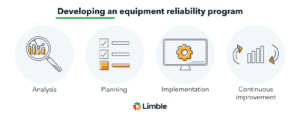Follow these steps for introducing an equipment reliability program to boost the availability and performance of all your critical assets.
An equipment reliability program is a systematic approach to assessing and optimizing the reliability of assets. As part of a broader maintenance program, they help contribute to availability and asset performance.
What is equipment reliability?
Equipment reliability, in the context of plant operations, reliability refers to an asset’s ability to perform its intended function without failure over a given period of time.

Four steps for developing an equipment reliability program to maintain critical assets.
4 steps for developing an equipment reliability program
Reliability management programs help to streamline maintenance planning, drive down maintenance costs, and maximize the effectiveness of critical assets. Here’s how to lay the foundation for more strategic reliability management in your organization.
1. Analysis
Introducing an equipment reliability program begins with getting to know each of your organization’s pieces of equipment.
An equipment criticality analysis ensures you have a data-backed understanding of each asset’s reliability and the cost of failure. Assess each piece of equipment. You can evaluate a given asset’s criticality based on a range of criteria including:
- The injury risk associated with asset failure
- The cost of repairing or replacing an asset
- The production impact of downtime
- The likelihood of unexpected breakdowns based on historical performance
2. Planning
Next, establish a cross-functional team to act on the results of your criticality assessment and begin planning your reliability program. Take care to clearly establish their roles and responsibilities as well as all relevant workflows for maintenance activities.
Your team should define the objectives of the program early and align on KPIs for measuring success. Aligning on goals and essential metrics will help establish a culture of excellence with team-wide commitment to the mission. Objectives of your program may include:
- Increasing the availability of assets
- Reducing unplanned downtime
- Extending the useful life of assets
- Improving product quality and customer satisfaction
- Establishing a safer, more productive workplace
They should each develop personal goals as well related to their position with the organization and role in the program.
During this stage, your team can dig into the different causes of equipment failure, identify the appropriate corrective actions, and begin organizing priorities with a Failure Mode and Effects Analysis (FMEA). This will set the stage for more proactive and preventive maintenance in the future.
3. Implementation
Next, it’s time to put your program into action. By adhering to newly established maintenance practices, embracing new methodologies, and leveraging tools for proactive monitoring, your team can begin improving the performance and availability of assets.
Your new maintenance program may include activities related to preventive or predictive maintenance, condition monitoring, and more. Whatever the program, ensure it is supported by robust training programs and carefully developed SOPs.
4. Continuous improvement
An emphasis on continuous improvement ensures your program’s maintenance practices evolve alongside business needs and that equipment stays reliable throughout its full asset lifecycle. As assets age, you can adjust your maintenance schedules and reliability improvement initiatives to more proactively address common equipment performance concerns.
If you recognize recurring problems with your program or specific pieces of equipment, conduct a root cause analysis to track the trouble to its source. Managing your program should involve maintaining a historical database of incident reports and performance data to help guide future improvements.
What do you need for equipment reliability management?
Do you have everything you need to introduce a program for managing equipment reliability and promoting proactive maintenance?
- An understanding of your organization’s assets
- A maintenance strategy informed by the health and criticality of business assets
- A well-trained team to carry out reliability management processes and maintenance tasks
- A system for capturing and reporting on asset health and performance
- KPIs and metrics to inform goal-setting and improvement initiatives
- A culture characterized by a team-wide commitment to continuous improvement
Reliability-centered maintenance (RCM)
Your equipment reliability program could serve as one component of a broader reliability-centered maintenance (RCM) strategy. RCM helps to identify the most cost-effective methods for preventing system failure and maintaining suitable operating conditions. Though RCM requires investments in technology to enable predictive monitoring and maintenance, it pays off in the long term. You’ll identify potential failures early and establish proactive methods for asset management.
Equipment reliability management made easy
Optimizing asset reliability isn’t a job for reliability engineers alone. Just as every critical asset contributes to product quality, every member of your team should contribute to managing and improving your equipment reliability program.
Implementing a computerized maintenance management system (CMMS) simplifies each aspect of your maintenance strategy. With Limble you can:
- Centralize maintenance tasks, work orders, work requests, and more
- Streamline your workflows to ensure high-priority tasks are completed first
- Report on a range of maintenance KPIs like MTTR and MTBF
- Keep technicians on task with detailed instructions for completing tasks and maintaining equipment reliability
Start your reliability journey with Limble today by signing up for a free demo or a free trial account.
